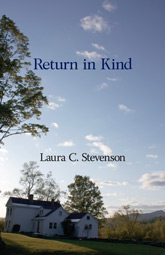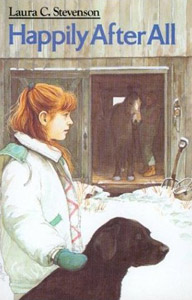A New Series: One Minute Reviews of
Books by Vermont Authors
Laura's column "One Minute Reviews" has appeared bi-weekly in Wilmington, Vermont's Deerfield Valley News since 2015. In April 2018, she found that no Vermont periodical consistently reviews all fiction and non-fiction by Vermont authors, so she started a series to fill that void. Published reviews from that series and some earlier reviews of local authors are listed with links to a scan of the printed copy. Reviews still in queue are listed without links until they appear in print.
The books reviewed in this series are available through Wilmington's Pettee Memorial Library, the Whitingham Free Public Library, and locally owned Bartleby's Books in Wilmington.
American Book Review, Jan/Feb 2021
How Poems Mean: Vermont Poets Discuss Their Work
Vermont Poets and Their Craft, eds. Neil Shepard and Tamra J. Higgins. Sundog Poetry/Green Writers Press, 2019
Vermont Poets and Their Craft originated as a ten-part lecture series delivered three years ago at Vermont bookstores and other venues under the auspices of Sundog Poetry Center, an organization founded by co-editor Tamra Higgins to promote poets and poetry throughout the state. The lectures, televised by Vermont Public Television, were subsequently revised for publication, and seven other Vermont poets were invited to submit pieces for an anthology. The result is a substantial collection of essays, all but one of which (Chard deNiord's mainly analytical "Suspense, Suspension, and the Sublime in the Poetry of Robert Frost") are concerned with the question classically worded sixty years ago in John Ciardi's title How Does a Poem Mean?
A reader searching this excellent anthology for common threads will find them less in the poets' different answers to Ciardi's question than in the similar success of their careers. Many of them teach or have taught at Vermont's colleges and universities; several are associated with the Bread Loaf Conference; two are present or past Vermont Poet Laureates, one a past Poet Laureate of Maine. Their professional reputations extend well beyond Vermont's boundaries, several of them have been awarded fellowships from Guggenheim and the National Endowment of the Arts, and many have received national poetic awards; their presses are widely distributed throughout the US. They are, for the most part, seasoned professionals: thirteen of the seventeen speak about their craft on the basis of thirty or forty years' practice. Behind their different styles and interests also lie common assumptions. The forbearers they revere—"our great grandparents of American poetry," as Neil Shepard puts it in "The Art of Concealing and Revealing in Poetry"—are Emily Dickinson and Walt Whitman. Baron Wormser's essay "The Irony and the Ecstasy" dwells upon the intensity of Polish poets who take poetry out of "the precincts of amiable sensitivity" and make it a "desperate call for fair play"; David Budbill's witty "Poetry: Special or Ordinary" draws on Taoist poets; but in the main, the quotations and their own works reveal their debt to Robert Frost, Elizabeth Bishop and other modernists of the previous century. Above all, they share Sundog Poetry Center's desire to reach out poetically to Vermont's present general audience.
In any state, such a general audience encompasses a variety of auditors, but it may be presumed that among them are experienced or nascent poets seeking fresh perspective or advice on their craft. To those seeking advice, several articles mix technical discussions with sophisticated literary understanding that raises them far above the level of 'how-to.' David Huddle's "Technique, Tradition, and the Lucky Lot of the Poet," the most Ciardian of the essays, discusses the techniques that makes certain lines in well-known poems by Frost, Thomas, and Bishop overwhelmingly powerful. Beautifully crafted poems like these, he argues, open the door for new poems: "one poet teaches another, one poem helps another make it into the world" (139). Stephen Cramer's "Making the Road: Tools for the Poet's Journey" starts by describing an exercise that encourages the "curiosity and investigation" that are necessary parts of poetic craft, then moves on with an excellent discussion of poetic diction. Sidney Lea's "Inviting the Reader: Narrative Values, Lyric Poems" argues for clarity in poetry, offering a rule of thumb that he applies to his own poems: "who, why, what, where? If my poem can't answer at least some of these questions, I feel I need to work on it further" (171). At the opposite end of the spectrum, Martha Zweig's "Gnarly" opens by asking "how can readily accessible communication possibly be a goal of poetry?" She prefers 'flirtatious' poems that begin by teasing the ear; and she suggests engaging in verbal calisthenics ("Roughhouse, rough trade, roughshod, roughage, ruffian, ruffle, kerfuffle") with the confidence that "meanings will suggest themselves along the chain" (238). The gradual emergence of poetry from a chaos of words is, in a very different mode, discussed in Geof Hewitt's "Baiting the Hook," as he describes the "quick-writing" he uses in public school poetry workshops to get "folks to write before they think" (118).
More theoretical discussions of craft appear in Greg Delanty's thoughtful "The Content Form" which analyzes the inter-relationship of poetic form and content; after analyzing several excellent examples, he concludes by suggesting that a reader of a poem should initially be unaware of the form the content takes, but when writing, poets must be so technically proficient that, like athletes, they are writing "in the zone" of their chosen form's demands. Major Jackson's "The Necessity of Language as Freedom," discusses the importance of description and figuration in poetry, with a fine analysis of the difference between the two techniques. Mary Jane Dickerson and Tamra Higgins present linked essays on "The Convergence of History and Poetry," each dealing with the technical and literary difficulties of converting research (on slavery, on the Korean War) into poetry.
Three of the younger poets in the collection move in slightly different directions than their seniors. Diana Whitney's "The Dense Fragrance That Rises from the Earth" reminds the reader that nature poetry is not necessarily "dry, dull or sexless," as it is "sometimes" maligned as being, "perhaps because it's been associated with Mr. Wordsworth rambling in the Lake District with journal in hand, writing about snowdrops and daffodils." Before lovers of Keats's nightingale or Shelley's West Wind can demur, she moves to "another tradition" of nature poetry that is written "from the body," and filled with "urgency and heat" (207). She examines this tradition as it appears in Pablo Naruda's love sonnets and fine poems from Jane Kenyon and Scottish poet John Burnside. Didi Jackson's "Writing Grief" moves towards confessional writing in her portrayal of the emotional release she found in poetry after her husband's suicide; unconsciously echoing Huddle's words about poems helping poets, she describes the way the poetry of Ruth Stone enabled her to write about personal loss. In a very different mode, Partridge Boswell's "Yes, but Could Homer Carry a Tune?" takes up the relationship between lyric poetry and lyrics of songs—a topic recently brought to international attention by Bob Dylan's Nobel Prize. One of Boswell's most interesting examples of the close connection of lyric and lyrics is his description of the way Brattleboro poet Wyn Cooper's poem "Fun" metamorphosed into Sheryl Crow's breakthrough hit "All I Wanna Do." The connection began when the group's producer chanced upon Cooper's poem just when the group was working on "a tune in need of a lyric"—and became a Grammy Award-winning song in part, Boswell implies, because Crow maintained the poem's language and syntax, thus remaining true to both forms.
The poetic interest displayed in this anthology ranges widely from the protest in Zweig's "gnarly" poetry through Lea and Budbill's plea for transparency to Hewitt's encouragement of performance poetry and Boswell and Shepard's the inter-connections of poetry and music. The variety is part of the anthology's strength, and it deserves a place on the bookshelves of serious poets far outside the state. Its tacit assumption that "Vermont" poets cluster around Burlington somewhat limits its range geographically and culturally. Southern Vermont poets, living closer to the Boston area, the Connecticut valley's Five Colleges, the Troy-Albany area of New York, and northern Connecticut than to Burlington, tend to mingle outside the state. That mingling has long complicated the definition of what Vermont poetry is, but the anthology could have benefitted from inclusion of those whose mingling has heightened their awareness of the diverse schools of poetry Simon briefly discusses at the end of his essay. Maybe we can hope for a more inclusive Volume II.


